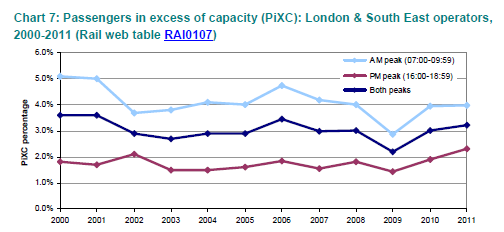All aboard! Are Britain's railways in need of high-speed relief?
Transport Secretary Patrick McLoughlin took centre stage in the House of Commons yesterday to unveil the Government's proposed route for the second phase of the High Speed 2 (HS2) rail network.
Basic route maps of the proposal have been spewed across almost all news reports and broadcasts, although anyone taking an interest can also view the route maps in fine detail from the Department for Transport (DfT) website.
In light of the proposals, it's worth bringing together what we know about the current state of the UK's rail network and why, as the Transport Secretary claims, increased capacity might be needed.
"Rail passenger numbers have doubled over the last 15 years, and demand will keep growing."
Join 72,953 people who trust us to check the facts
Sign up to get weekly updates on politics, immigration, health and more.
Subscribe to weekly email newsletters from Full Fact for updates on politics, immigration, health and more. Our fact checks are free to read but not to produce, so you will also get occasional emails about fundraising and other ways you can help. You can unsubscribe at any time. For more information about how we use your data see our Privacy Policy.
True. Figures on passengers using the railway are available from the Office for Rail Regulation (ORR). The graph below shows data on the most useful measure here of 'passenger journeys', combined with data from the House of Commons Library:

In 2011-12 there were 1.4 billion passenger journeys on UK railways. Full Fact discovered some time ago that evidence indicates rail travel is now at its highest level since the 1920s, although the data going back this far is, as we might expect, somewhat patchy.
It also won't come as a surprise that the DfT believes passenger demand will continue to grow in the years to come, in spite of the recession. In 2010 the National Audit Office analysed the Government's projections (here presented in passenger kilometers travelled rather than journeys).

"The west coast main line is filling up. There is not enough space for all the commuters, freight trains and inter-city trains that need to use it."
True. Every morning there are 21,000 more passengers going into London alone. The case for the West Coast mainline is outlined in more detail by Network Rail, which highlights that for many parts of the mainline:
"Growth may be difficult to accommodate without affecting performance. Current traffic is constraining timetabling elsewhere."
The inability of the existing railway to meet growing passenger demand is a central argument made by HS2 proponents. Network Rail itself claims a "fast approaching rail capacity crisis". So what evidence do we have that our rail network is becoming increasingly strained?
The only available figures that can give us some indication are those on overcrowding for peak services, again provided by the ORR and the DfT. Overcrowding is defined in terms of 'passengers in excess of capacity' where capacity (for standard class) is the number of standard class seats on the service plus an allowance for standing (this varies but is typically 35% of the number of seats).
The figures for 2011 show that on a typical weekday, 532,000 passengers arrive into London during the morning peak and 443,000 depart in the evening peak. Birmingham enjoys the highest intake outside London, with 36,000 arriving in the morning and 40,000 departing in the evening.
Overcrowding into and out of London across both peaks stands at 3.2% - this means that out of all passengers travelling to or from London, 3.2% are 'in excess of capacity'. The same figure for the morning peak alone is 4%. In other words, there are 21,000 people too many for the rail network to cope.
This isn't, of course, uniform across all services. The DfT revealed at the end of last year that the most overcrowded peak service into a major city is the 07:44 from Henley-on-Thames to London Paddington. Overcrowding on this service, measured in the same way as above, stands at a staggering 44%.
The DfT also provide some helpful diagrams to explain the problem throughout a typical weekday in central London (obviously this pattern varies between routes):

But is this a growing problem?
Yes, without any change in the capacity of services as passenger numbers increase, overcrowding is going to be a growing problem. But are train operators keeping pace with rising demand?
Perhaps surprisingly, the trend of overcrowding as measured by passengers in excess of capacity, hasn't been one of significant increase over the past decade. Considering first the picture since 2000 (for London and the South East, again data for anywhere else is scant):

The trends across a decade have shown little by the way of increased overcrowding. The same picture is apparent taking the scale back to 1990, although this reveals an increase in overcrowding post-privatisation, consistent with a significant increase in passengers over the same period:

These trends don't mean there isn't a growing problem. While train operators have been able to increase capacity to cope with rising demand, such as by adding seating space and increasing the frequency of services, there will logically come a point where the existing infrastructure can't take on more services or carriages on trains. One of the ongoing debates will be whether HS2's drawbacks justify the extra capacity it will bring to parts of the rail network.
---
Flickr image courtesy of Michael Kappel